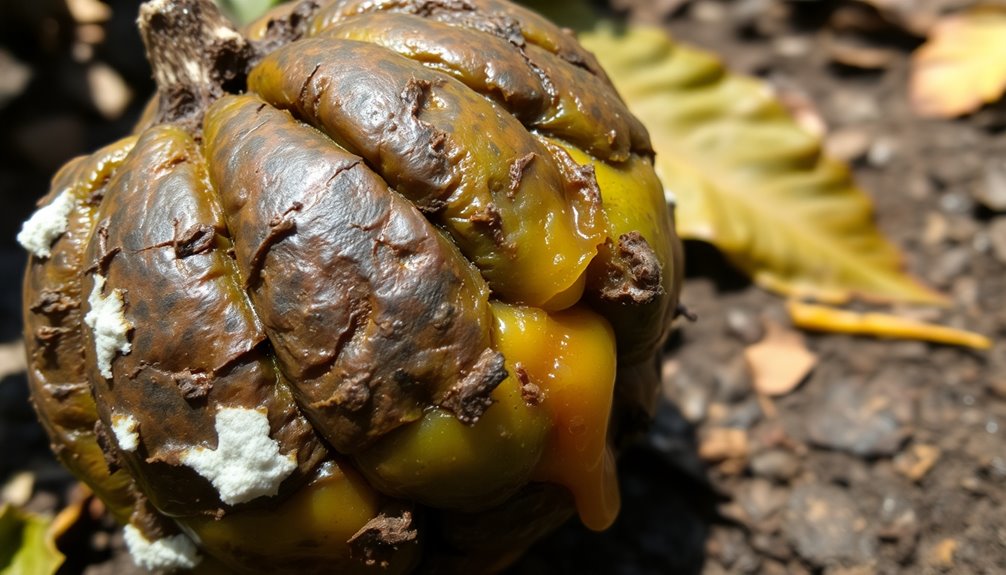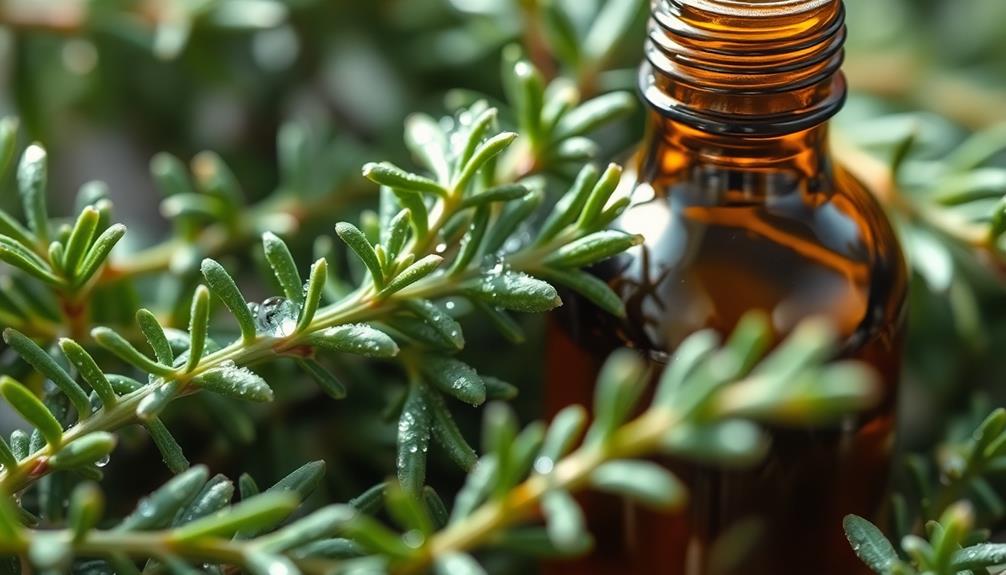Formic acid has a sharp, acrid smell similar to vinegar. You're likely to notice it when certain ant species release it as a defense mechanism, especially in areas with active ant colonies. The scent is pungent and can be overwhelming, particularly in concentrated forms. It's also produced during fermentation and found in plants like stinging nettles. Be cautious, as the odor can trigger discomfort and indicate potential health risks. If you're curious about where else this scent appears or how it impacts the environment, you'll find even more interesting details ahead.
Key Takeaways
- Formic acid has a sharp, acrid odor similar to vinegar, becoming more intense in concentrated forms.
- The smell is often described as pungent and can evoke discomfort or avoidance.
- It can be detected at low concentrations, with an odor threshold of 0.5 to 1.0 ppm in the air.
- The scent is commonly associated with areas where wood ants are active, releasing a vinegar-like odor during disturbances.
- Its odor may trigger memories of outdoor activities like hiking or camping, influencing emotional responses.
Introduction

Formic acid, a simple carboxylic acid, has a unique and potent smell that many people find memorable. When you encounter this pungent odor, it's often associated with ants, as these tiny creatures produce and release formic acid when they feel threatened. This distinctive smell can evoke a sharp, irritating sensation, especially in its concentrated forms.
You'll recognize formic acid's aroma even in low concentrations, as its strong, acrid scent is hard to miss. It's not just the ants that bring this smell to mind; you might also associate it with food preservation or fermentation due to its use in agricultural applications. So, whether you're outdoors and catch a whiff from a colony of ants or indoors from preserved foods, the scent of formic acid can trigger olfactory memories.
Understanding this smell helps you appreciate its role in nature and human activities. The next time you come across that pungent, irritating aroma, you can confidently identify it as formic acid, a compound that's both fascinating and essential in various contexts.
Description of the Smell

The smell of formic acid strikes you as sharp and acrid, reminiscent of vinegar with a more intense bite. This pungent odor can be particularly irritating, especially in concentrated forms. You might notice it in industrial settings or when squished ants release the substance, creating an unmistakable scent that lingers in the air. The odor is distinct and can evoke strong reactions in those sensitive to it, leading to discomfort or even avoidance behaviors.
When you encounter the smell of formic acid, it's hard to ignore. It often permeates environments where large groups of ants are disturbed, adding to the overall olfactory profile of the area. The concentrated nature of this acid amplifies its intensity, making it a potent reminder of its presence.
You might find that the smell of formic acid stays with you, a sharp reminder of its source. This compound's irritating qualities can leave a lasting impression, making you think twice about where you step or what you disturb. Overall, the odor of formic acid is a powerful and evocative experience, one that you won't soon forget.
Source and Composition

In nature, formic acid primarily comes from certain ant species, which produce it as a defense mechanism against predators. This chemical, known scientifically as HCOOH, is the simplest carboxylic acid and has a pungent, acrid smell often compared to vinegar due to its acidic nature. When you encounter the smell of formic acid, it's likely because ants are nearby. They release this compound when threatened or squished, contributing to their distinctive scent profile.
Besides ants, formic acid is also found in the venom of some insects, further linking its presence to the animal kingdom. The chemical is soluble in water, methanol, and ether, making it detectable in various environments and chemical contexts. This solubility means that even small amounts can create a noticeable odor, reminding you of its potent nature.
When you think of formic acid, picture not only the smell but also the tiny creatures that produce it. Understanding its source helps you appreciate the role this pungent chemical plays in nature, serving both as a warning and a defense mechanism for those little ants.
Typical Scenarios or Environments

Many people notice the scent of formic acid in natural environments, especially where wood ants thrive. When these ants feel threatened or are squished, they release a pungent odor that closely resembles vinegar. This smell isn't just a casual whiff; it's a chemical that smells strong enough to alert nearby predators. In areas where ant colonies are disturbed, you might catch a whiff of this distinctive scent lingering in the air.
You may also notice this odor in your garden or forest, where the presence of wood ants is prominent. They produce formic acid as a defense mechanism, creating a strong olfactory signature. Additionally, dead ants release oleic acid, which can mix with formic acid, resulting in a complex aroma that might remind you of a freshly dressed salad or olive oil.
In agricultural settings, you might detect the smell of formic acid when it's used as a preservative in livestock feed. This adds to the overall scent profile in barns or silos, making it another typical scenario where the smell of ants and their byproducts becomes noticeable.
Emotional or Cultural Associations

Formic acid's sharp, vinegar-like scent can evoke a range of emotional responses, often tied to personal experiences in nature. When you smell formic acid, it might trigger memories of hiking or camping, where encounters with ants are common. This connection can create a mix of nostalgia and discomfort, as the pungent odor reminds you of those outdoor adventures.
Cultural contexts also play a significant role in shaping your emotional associations with the smell of formic acid. In some cultures, the scent, linked to ants and other insects, can symbolize pestilence or infestation. This leads to negative responses, making the smell feel more like a nuisance than a natural occurrence. However, understanding the ecological roles of ants and their chemical defenses can shift your perspective. Instead of aversion, you might feel curiosity about their important functions in the environment.
Ultimately, formic acid's smell can stir a complex web of emotions, reflecting both personal experiences and broader cultural interpretations. Embracing these associations allows you to appreciate the intricate connections between scent, memory, and nature.
Health or Safety Considerations

When handling formic acid, it's crucial to be aware of its hazards. This pungent, vinegar-like smell can be unpleasant and signals its corrosive nature. Exposure to formic acid can lead to severe health issues, such as skin burns and eye damage. If you inhale its vapors, you might experience respiratory problems and systemic toxicity, which could jeopardize your health.
Due to these dangers, OSHA classifies formic acid as a hazardous substance, enforcing strict safety measures in workplaces. The permissible exposure limit (PEL) for formic acid vapor is set at 5 parts per million (ppm). This regulation aims to minimize health risks associated with exposure and ensure your safety while working with this chemical.
Chronic exposure to formic acid may lead to potential kidney damage and skin allergies, emphasizing the importance of monitoring exposure levels diligently. Always wear appropriate personal protective equipment (PPE), such as gloves and masks, to reduce the risk of contact and inhalation. By taking these precautions seriously, you can effectively safeguard your health while working with formic acid. Remember, safety is paramount when dealing with any corrosive substance.
Final Thoughts

Understanding the characteristics of formic acid, including its distinct smell, is important not just for safety but also for recognizing its presence in various environments. You'll notice that formic acid emits a pungent, vinegar-like odor, which many people associate with ants. This odor becomes particularly prominent when ants feel threatened or are squished, releasing the compound into the air.
The smell can be quite unpleasant, often reminiscent of burnt or sour scents. Because formic acid acts as a strong irritant, even low concentrations can be detected by most individuals. However, sensitivity to this odor can vary; some people are more attuned to its presence due to genetic factors.
In environments where formic acid is present, being aware of its distinctive odor can help you identify potential issues, such as ant infestations or the presence of certain plants. Overall, understanding the smell of formic acid not only aids in recognizing its presence but also emphasizes the importance of caution due to its irritating properties. Keep this in mind as you navigate environments where you might encounter this compound.
Frequently Asked Questions
Does Formic Acid Have a Smell?
Yes, formic acid does have a distinct smell. You'll likely notice its pungent, acrid scent, which can remind you of vinegar. When it's concentrated, the odor becomes even stronger and more irritating, making it hard to ignore. Its volatility means that even small amounts can produce a noticeable aroma, triggering strong sensory responses. So, if you encounter it, be prepared for a potent olfactory experience.
What Is the Dead Ant Smell?
When you encounter the smell of dead ants, you might notice it has a distinct, somewhat oily scent, similar to freshly dressed salad or olive oil. This aroma comes from oleic acid released by the deceased ants. Your sensitivity to the smell can vary, so you may find it more potent in areas with numerous ants. This scent acts as a chemical signal, alerting other ants to the presence of their fallen colony members.
Does Formic Acid Smell Bad?
Yes, formic acid does smell bad. You'll likely notice its pungent and acrid odor, which can be quite unpleasant. If you're exposed to it, especially in higher concentrations, you might experience irritation in your nose and throat. The smell can be strong enough to cause discomfort and even a burning sensation in your mucous membranes. So, if you encounter it, make sure to take necessary precautions to avoid inhaling its vapors.
What Is the Smell When You Crush an Ant?
When you crush an ant, you'll notice a distinctive smell that varies based on the species. Some ants release a vinegar-like odor due to formic acid, while others might emit a chocolatey scent or a citrus aroma. If you happen to squish a dead ant, you might catch a whiff of oleic acid, which smells somewhat like olive oil. Each ant's unique chemical makeup contributes to its specific scent profile.









